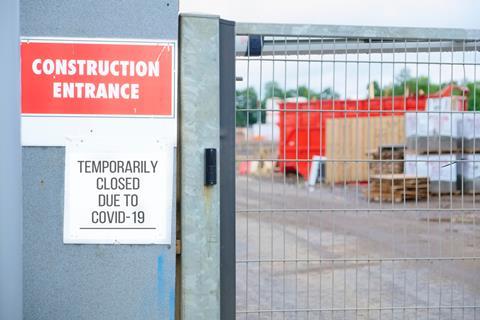Number of construction firms which have defaulted on bounceback loans has jumped by 40% in a year, according to Price Bailey
A surge in construction firms defaulting on covid loans suggests the number of failures like that of Buckingham Group are likely to rise, new analysis has found.
Evidence gathered by accountant Price Bailey also suggests that industry bosses are underestimating their insolvency risk at a time when high interest rates are increasing the cost of servicing loans.
Coronavirus Business Interruption Loan schemes (CBILS) were launched by the government in March 2020 at the beginning of the first pandemic lockdown to support small and medium sized firms with loans of up to £5m.
Over 14,000 construction firms were awarded CBILS with loan terms of up to six years.

Data obtained by Price Bailey from the British Business Bank found that 1,084 firms have now defaulted at least once on their loans, representing nearly 8% of all borrowers in the industry.
This is an increase of 40% on the 775 firms which had defaulted at least once 12 months ago.
Separate analysis by the accountant found many construction bosses appear to have too optimistic a view of their financial stability, raising the possibility of a wave of business failures.
A survey of over 700 construction businesses showed that 84% think they have a low insolvency risk, up from 77% this time last year, despite insolvencies rising by nearly a fifth over the same period.
Price Bailey partner Chand Chudasama said: “There is a worrying mismatch between the perception many construction industry bosses have of insolvency risk and the financial reality. This is likely to be contributing to a higher level of business failures as many of these insolvencies could possibly be avoided with better risk management.”
“Lack of preparation for a sudden change in fortunes caused by the loss of a large contract or the late payment of a major invoice can have fatal consequences for a business. Construction bosses must focus on maintaining live and accurate management information across all three financial statements and plug this live and historical financial data into forecasts to underpin decision making.”
He adds: “It is also critical to actively manage work in progress, cash and milestone payments to get ahead of problems.”
Insolvencies in the construction industry hit their highest level in a decade in the second quarter of 2023, with 1,176 firms going bust.
Price Bailey warned the situation is being exacerbated by the growing cost of servicing loans, with Bank of England base rates having increased from 3.5% at the beginning of 2023 to 5% by the end of quarter two.
The base rate currently stands at 5.25% and is expected to rise by a further 0.25% this month.
Chudasama added: “A growing number of construction businesses which are highly leveraged are struggling to repay loans as interest rates rise. Higher rates will likely feed through to higher CBILS defaults, which will in turn fuel an increasing number of business failures.
“Many building contractors are tied into fixed price contracts which quickly become under-priced as inflation eats away at margins. As construction cost inflation has continued to rise, many contracts have become unviable. Larger builders with multiple sites can offset losses from under-priced developments but small builders with a single site may have no option but to deliver projects at a loss.”
He adds: “A sizeable proportion of smaller construction businesses are finding it difficult to compete with the lower prices offered by larger businesses, with many avoiding passing on the increases for fear of tainting customer relationships. It is these businesses which are most vulnerable to cashflow problems and therefore likely to default on CBILS.”
Official figures published today showed UK construction output fell by 0.5% in July following a 1.6% increase in June, with the figures suggesting that the main driver of the slowdown was a decrease in repair and maintenance work due to wet weather.




























No comments yet